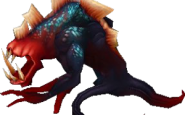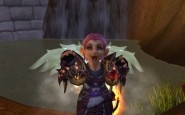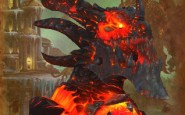
It’s about this time in the WoW expansion cycle that my mind inevitably turns to alts. Why? I’m not sure. I think it’s the sense of progression I get from levelling up and acquiring gear, spells and power, as well as the lack of pressure and time limits: no one’s forcing me to conform to a timetable or level at a certain rate, and it’s quite liberating.
But which class?
I already have a Shaman, Druid, Paladin, 2 Priests and a Warlock (every family has a black sheep, after all).
The trouble is, I’m not a fan of pure DPS classes. I find the kill-it-quick-before-it-can-kill-you playstyle a bit of a challenge, even though I know that, objectively, DPS classes have an easier time levelling.
I’ve also never quite got the hang of melee DPS either. I find it hard to feel immersed in the action unless I have the camera zoomed in fairly close, and then I feel blinkered because I can’t see behind me.
Long story short: I decided to roll yet another Priest. And because that’s the sort of person I am, I’m levelling Holy (again).
Don’t you get bored?
The short answer is no! Each time I’ve picked a different race, across both factions, and have been effectively playing a different game each time.
When I was levelling Malevica, way back in mid-2007, the Burning Crusade had only been out about 8 months, and the Black Temple was new content. Levelling back then was a very different proposition from my second Priest, who was a child of Wrath, but who didn’t have any of those fancy heirlooms to help her level.
And this time around I’m not only in a full set of heirlooms, but I’m also able to take advantage of the changes to the “introductory experience” and the quest objectives tracker that came with Patch 3.3.0 in December 2009.
From the patch notes:
A number of changes have been made to World of Warcraft’s introductory experience, including updated character and class information at the character-selection screen, more robust tooltips with images, improved health and mana regeneration at lower levels, and adjustments to various classes designed to make it easier for players to get started. In addition, all-new quest-tracking features have been added to assist players in finding objectives, including new interface functionality in the quest log, the map (“M” key), and the Objectives pane.
So how are those changes working out?
Well, the updated character and class information is a small but useful improvement. It now puts class and race characteristics at the top of their respective boxes rather than below so you can glance across easily, and the class description lists primary stats (“Spell Power, Intellect and Spirit if healing”), which is helpful for a new player to know. Unfortunately for our Druidic and Shamanistic brethren and sistren (is that a word?) “their primary stats depend on their role”, which doesn’t help a new player much.
One little thing I do miss, and I have no idea when it disappeared, is the little button to generate a random name. I know, I know, I should spend hours coming up with a name that fits my character, but it’s much easier to pick a suitable-sounding name from a list than try and make something up.
Given the names I’m coming across in Elwynn Forest though, I suspect I’m largely alone in this.
Another big change is that all the mobs in the starting zones are now yellow, so they won’t attack you unless attacked and they won’t link. I don’t recall dying much in the starter zones before, but I suppose if you’re really new to this sort of thing, getting a bit more time to get to grips with the interface is of benefit.
The final change I want to talk about is the change to mana and health regeneration. Both of these have been massively boosted (outside combat) for the very low levels. From the PTR patch notes at the time:
Health and Mana Regeneration: These regeneration rates have been increased by up to 200% for low level characters. As a player’s level increases, the regeneration rates gradually reduce, returning to normal rates at level 15.
Great, so you don’t need to worry about eating and drinking along with all the other things that you need to get to grips with at low levels. But wow, did I ever get myself in trouble around level 12 when that gradual reduction started to bite. From regenning all my mana between mobs, I very quickly found myself with almost no mana regen at all, and it caught me out on more than one occasion, pulling with only a couple of Smites in the tank and then whacking things with my staff until they died.
I like the feature, but please, please signpost this better! If I spend 10 levels getting used to something, it’s rough to take it away without warning. And the slope could benefit from some flattening too, the transition from infinite mana to permanently running on fumes felt like only a level or two.
Talent choices
By level 15 I’ve amassed an almighty 6 talent points to spend. Looking at the talent trees, frankly I’m underwhelmed with Holy and Discipline. I know I’ll need to spend some points there sooner or later, because the higher talents are so delicious, but for now I want to boost my power.
The best place for the first 3 points is probably Spirit Tap . The first half of the tooltip is what we’re interested in with Spirit Tap. Doubling your spirit gives a big boost to your mana regeneration, helping you to recover for the next mob. The second part helps if you’re pulling multiple mobs, or pulling mobs in quick succession.
Improved Spirit Tap is quite a lot weaker, because it doesn’t boost your spirit much, mobs won’t live long enough to make a short period of increased regeneration worth it, and it relies on spell critical strikes. Your crit rating is likely to be pretty low, so you’ll not see much benefit from this one.
Other than that, your choice of points is pretty much free. I’d recommend sticking with the Holy tree for a while, until you can get to Divine Fury, but your choice from Tier 1 depends strongly on whether you’re going solo PvE/questing or going to be instancing your way to 80. For solo play, Holy Specialisation is probably the better choice, while a dungeoneer might prefer to boost their healing output with Improved Renew and Healing Focus.
Glyphs
At level 15 the first two of your glyph slots opens up: one major and one minor.
Major Glyphs at level 15:
| Glyph of Fade |
Reduces your Fade cooldown by 9 seconds. Practically irrelevant at this point, and at most other points in the game too. Not recommended. |
| Glyph of Inner Fire |
Increases the armour bonus from Inner Fire by 50%. This one could be good for survivability and keeping your shield up longer, although killing faster is probably more desirable unless you’re dying a lot. |
| Glyph of Power Word: Shield |
Your Power Word: Shield also heals the target by 20% of the shield amount. Good to have in dungeons for a bit of freebie healing, but not game-breaking. Possibly a good choice for a dungeoning healer, less useful for a quester. |
| Glyph of Psychic Scream |
Increases the duration of Psychic Scream by 2 seconds, but increases its cooldown by 8 seconds. I tend to avoid using Psychic Scream most of the time because if I’m in trouble already the last thing I need is mobs running around bringing in friends. I’d leave this one for PvP, I think. |
| Glyph of Renew |
Reduces the duration of your Renew by 3 seconds, but increases the amount healed per tick by 25%. This means it’s a neutral change in total output but makes Renew higher throughput. Very handy in dungeons to help support a tank, but not worth the slot in solo play. |
| Glyph of Shadow Word: Pain |
The periodic damage ticks of your Shadow Word: Pain spell restore 1% of your base mana. Given that Shadow Word: Pain ticks 6 times, that brings its mana cost down to around the same as Smite. If you use SW:P a lot then this might be worth a look, but I think there are better options. Very much dependent on playstyle. |
| Glyph of Smite |
Your Smite spell inflicts an additional 20% damage against targets afflicted by Holy Fire. Although you don’t get Holy Fire until level 20, this one will be very powerful past that point. |
Minor Glyphs at level 15:
| Glyph of Fading |
Reduces the mana cost of your Fade spell by 30%. Since you will rarely use Fade, it seems unlikely that this glyph will give you much value. |
| Glyph of Fortitude |
Reduces the mana cost of your Power Word: Fortitude and Prayer of Fortitude spells by 50%. Does what it says on the tin. |
For Minor glyphs there’s not much to be excited about. You’re probably more likely to case PW:F, so I’d recommend that one.
For Major glyphs you have a choice depending on your playstyle and where you think you’re weak. I’d recommend the Glyph of Smite for soloing, because although Holy Fire is a level 20 spell, your next Major glyph slot doesn’t open up until level 30. You can always use another glyph in the meantime.
If you prefer instancing, consider either the Glyph of Renew if you’re needing a boost on tanks or Glyph of Power Word: Shield if you’re finding yourself healing the non-tanks more often.
How’s that toolbox looking?
These first few levels actually give Priests quite a versatile toolkit already. We have a HoT, a direct heal, a shield, a DoT, two direct damage spells, a resurrection, two buffs (albeit one self-only), a dispel, a panic button (Psychic Scream) and the slightly out-of-place Fade.
Low levels are characterised by Smite spam, primarily, with Mind Blast thrown in if you can spare the mana. Shadow Word: Pain is probably too expensive to be worth using at very low levels, since it costs one and a half times as much as a Smite for about the same damage, and you probably won’t use the full duration anyway.
Once you get Power Word: Shield, this becomes the opener before every pull. It’s not cheap, but no pushback on spells means fights go so much more smoothly. Plus, often I found that a PW:S absorbed all the damage a mob could do to me before it died, especially once I got Inner Fire (armour affects the size of the hit before absorbs are taken into account, so you absorb more, smaller hits with IF up).
Fade is an anomaly here, slightly at odds with the simplification of the game at low levels. You get given it at level 8, but since it has zero effect in solo play, and you can’t enter dungeons until the early teens, and no one really manages aggro in Ragefire Chasm anyway, I’m puzzled that it’s not given to us a bit later, nearer level 20 or so when dungeons become a bigger part of the experience.
Anyway, let’s check up on our Priestly toolkit so far. New spells are in green so we can track the evolution of the Priest.
| Spell |
Obtained at level |
Current Rank (level 15) |
| Lesser Heal |
1 |
3 |
| Power Word: Fortitude |
2 |
2 |
| Smite |
1 |
3 |
| Shadow Word: Pain |
4 |
2 |
| Power Word: Shield |
6 |
2 |
| Fade |
8 |
– |
| Renew |
8 |
2 |
| Mind Blast |
10 |
1 |
| Resurrection |
10 |
1 |
| Inner Fire |
12 |
1 |
| Cure Disease |
14 |
– |
| Psychic Scream |
14 |
1 |
Any other tips?
Here goes:
- Don’t worry too much about Shadow Word: Pain. It’s just not worth the mana at low levels.
- When you get to around level 10, go buy yourself some Ice Cold Milk from an Innkeeper or drink vendor. You’ll be needing it soon.
- If you can afford it, pick up a wand when you pass through a city. Enchanters make loads of Lesser Magic Wands and Greater Magic Wands as they skill up, so supply tends to be high. Wanding for the last few seconds of a fight saves you mana from casting a big spell on something almost dead, and gets you into the not-casting, higher regeneration period earlier, so you’ll have more mana for the next fight.
- When you get to level 11 or 12 and you’re done with your faction’s area, consider skipping Westfall/Barrens/Silverpine/etc and instead heading off to either the Blood Elf or Draenei intermediate zone instead. Because they were introduced in The Burning Crusade, they benefited from much neater quest locations and flow, and tend to give more appropriate and useful rewards.
- If you’re thinking of taking up a gathering profession, go to your Capital and pick the profession up early. Once you get to the level 12-20 zones you’ll find the starter nodes are more sparse and the next rank of nodes require skills of 50+
Next time
Level 15 opens up the random dungeon finder, so stay tuned for the fun and shenanigans!
Possibly Related Posts:









